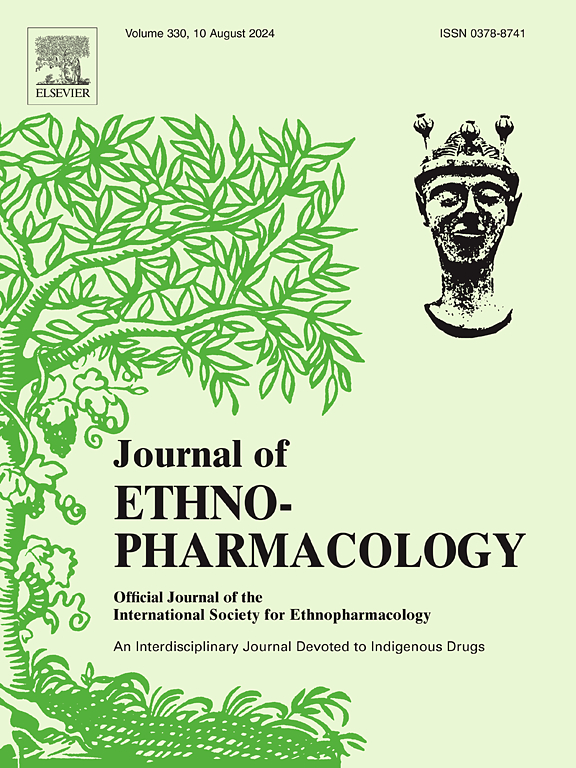苦参标准化及其对Wistar大鼠三甲基锡痴呆的神经保护作用:对认知功能和氧化应激调节的见解。
IF 5.4
2区 医学
Q1 CHEMISTRY, MEDICINAL
引用次数: 0
摘要
民族药理学研究表明,甘草是一种由glycyrhiza glabra L. (Yashtimadhu)和Benincasa hispida (Thunb)合成的复方草药。Cogn。(库什曼达)在ghrita(牛的酥油)中,作为其活性化合物的载体。据报道,Yashtimadhu和Kushmanda具有增强记忆和抗氧化活性。研究目的:本研究旨在使苦参标准化,并评价其对三甲基锡致白化Wistar大鼠痴呆的神经保护作用。材料与方法:根据AYUSH规程对库什曼达格里塔的各项参数进行标准化。建立并验证了高效液相色谱法对芦丁、甘草酸、没食子酸、槲皮素等标记物进行标准化。通过运动活动、行为参数(Morris水迷宫、高架迷宫、社会识别测试和新物体识别测试)、生化参数(丙二醛、谷胱甘肽和过氧化氢酶)和组织病理学研究等既定参数,评估三甲基锡诱导痴呆大鼠的神经保护作用。结果与讨论:除感官特性外,对苦参的比重、粘度、折射率、干燥损失、pH值、酸败度、碘值、皂化值、酸值、过氧化值、重金属测试(As、Cd、Hg和Pb)、微生物污染测试和特定病原体测试进行了标准化。建立了一种新的HPTLC方法来同时检测和定量选定的标记(ICH Q2 R2指南)。库什曼达格里塔治疗组显著改善了大鼠认知和记忆三甲基丁诱发的痴呆。它还能降低丙二醛、谷胱甘肽和过氧化氢酶的水平,从而减少大脑中的氧化应激。此外,一项脑组织病理学研究显示,与患病动物相比,库什曼达灵塔治疗动物的神经元结构损伤更小。结论:建立了一种准确、精密度高、稳健性好、专属性强的hplc分析方法。基于药理活性数据,该研究得出结论,库什曼达格里塔有效降低氧化应激,防止海马神经元损伤,可能是由于学习和记忆增强活动。本文章由计算机程序翻译,如有差异,请以英文原文为准。

Standardization of Kushmanda Ghrita and its neuroprotective effect in trimethyltin-induced dementia in Wistar rats: Insights into cognitive function and oxidative stress modulation
An ethnopharmacological review reveals that Kushmanda ghrita is a polyherbal formulation made from Glycyrrhiza glabra L. (Yashtimadhu) and Benincasa hispida (Thunb.) Cogn. (Kushmanda) in ghrita (cow's ghee) and serves as a carrier for its active compounds. Yashtimadhu and Kushmanda have been reported to exhibit memory-enhancing and antioxidant activity.
Aim of the study
This study aimed to standardize Kushmanda ghrita and evaluate its neuroprotective activity against trimethyltin-induced dementia in albino Wistar rats.
Materials and methods
Kushmanda ghrita was standardized for various parameters according to the AYUSH protocol. The HPTLC method was developed and validated to standardize Kushmanda ghrita for the markers rutin, glycyrrhizin, gallic acid, and quercetin. Well-established parameters, such as locomotor activity, behavioral parameters (Morris water maze, elevated plus maze, social recognition test, and novel object recognition test), biochemical parameters (malonaldehyde, glutathione, and catalase), and histopathological studies were performed to evaluate the neuroprotective effects of trimethyltin-induced dementia in rats.
Results and discussion
In addition to its organoleptic properties, Kushmanda ghrita was standardized for its specific gravity, viscosity, refractive index, loss on drying, pH, rancidity, iodine value, saponification value, acid value, peroxide value, heavy metal test (As, Cd, Hg, and Pb), microbial contamination test, and specific pathogen tests. A novel HPTLC method was developed to simultaneously detect and quantify selected markers (ICH Q2 R2 guidelines). Kushmanda ghrita treated groups significantly improved cognition and memory trimethyltin-induced dementia in rats. It also reduces malondialdehyde, glutathione, and catalase levels, thereby reducing oxidative stress in the brain. In addition, a brain histopathology study revealed less damage to neuronal structures in Kushmanda ghrita-treated animals than in diseased animals.
Conclusion
Kushmanda ghrita was standardized, and an accurate, precise, robust, and specific HPTLC analytical method was established. Based on the pharmacological activity data, the study concludes that Kushmanda ghrita effectively reduces oxidative stress and prevents damage to hippocampal neurons, probably due to learning and memory enhancement activity.
求助全文
通过发布文献求助,成功后即可免费获取论文全文。
去求助
来源期刊

Journal of ethnopharmacology
医学-全科医学与补充医学
CiteScore
10.30
自引率
5.60%
发文量
967
审稿时长
77 days
期刊介绍:
The Journal of Ethnopharmacology is dedicated to the exchange of information and understandings about people''s use of plants, fungi, animals, microorganisms and minerals and their biological and pharmacological effects based on the principles established through international conventions. Early people confronted with illness and disease, discovered a wealth of useful therapeutic agents in the plant and animal kingdoms. The empirical knowledge of these medicinal substances and their toxic potential was passed on by oral tradition and sometimes recorded in herbals and other texts on materia medica. Many valuable drugs of today (e.g., atropine, ephedrine, tubocurarine, digoxin, reserpine) came into use through the study of indigenous remedies. Chemists continue to use plant-derived drugs (e.g., morphine, taxol, physostigmine, quinidine, emetine) as prototypes in their attempts to develop more effective and less toxic medicinals.
 求助内容:
求助内容: 应助结果提醒方式:
应助结果提醒方式:


